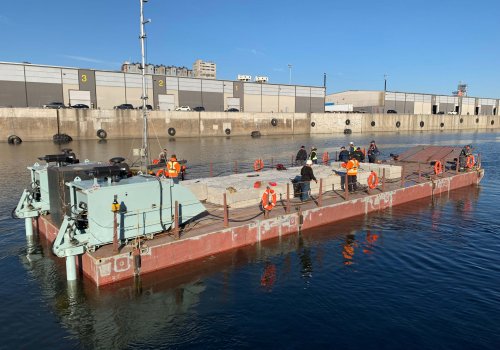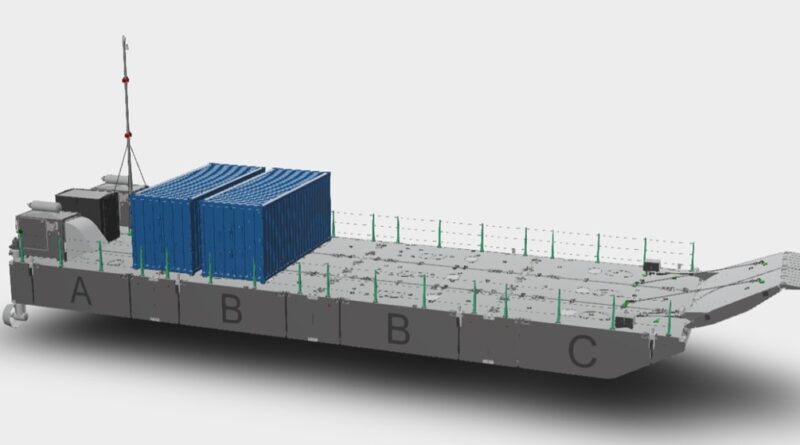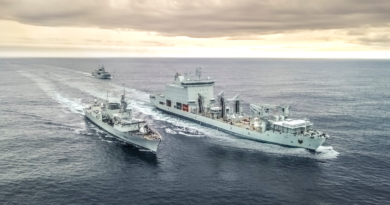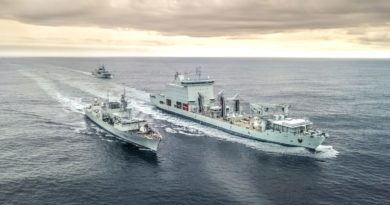Ship-to-Shore Connector Barges
The Royal Canadian Navy (RCN) will acquire four1 self-propelled modular barges, to be built by Navamar of Montreal for the Department of National Defence’s (DND) Ship-to-Shore Connector (SSC) project, that project part of the larger Joint Support Ship (JSS) project. The SSC barges will provide an enhanced capability primarily to Protecteur-class ships being built by Seaspan for the JSS project, enabling those ships to transfer to and from shore, mission essential equipment, stores, and personnel for various Canadian Armed Forces missions.
Through use of the SSC barges the RCN will be able to support a range of operations by naval groups and joint task forces (JTF). Operating in sheltered waters, the SSC system will be able to deliver heavy and large amounts of equipment and sizeable numbers of personnel to areas that do not have adequate shore facilities, whether from poor infrastructure or due to damage to existing infrastructure. The system represents a significant enhancement of the RCN’s capability to transfer people and material, which previously depended on ships’ boats and the small LCVP (landing craft, vehicle, personnel) of the older Protecteur-class replenishment oilers, now disposed.
The self-propelled barges could provide direct support to Humanitarian Assistance and Disaster Relief (HADR) and Non-combatant Evacuation Operations (NEO). For HADR, the barges will be capable of landing relief personnel, equipment and supplies to assist people in devastated areas ashore, especially where landing facilities are not available. For NEO, the barges will be capable of effectively transporting large numbers of non-combatants and non-essential military personnel from danger in an overseas country to safety in a Protecteur-class ship. While primarily intended to be employed with this class of ships, the barges could also be operated from other Canadian government vessels and from civilian ships. The barges could also operate directly from shore, within a port, in inland waterways, or even in an Arctic environment in ice-free areas.
In addition to delivering personnel and cargo, the barges can ferry specialized equipment to or from shore to support operations. In suitable sea conditions, the system could be used to establish a ‘floating work point’ whilst maintaining a minimal footprint ashore or onboard ship to support small-scale command and control, boat, diving, salvage, medical, administrative, research, mechanical repair, or even force protection activities through the use of additional equipment ranging from tents to stand-alone specialized container-based payloads. The barges are not the type of vessels that would be used in amphibious operations as commonly understood, that is, an assault landing in the face of opposition, but could support the follow-on movement of amphibious forces (which would be allied, as Canada does not maintain amphibious forces).
Each SSC barge will be able to carry 50 tonnes of cargo at a speed of 5 knots in sheltered harbours where a ship cannot come alongside. Its beaching capabilities with roll-on/roll-off ramp will provide the RCN a high degree of flexibility in supporting HADR, NEO and other JTF operations ashore. The modular pontoon barges are assembled in the water with the flexibility to load anything from vehicles to sea containers of supplies, and subsequently shuttle these to shore.
The first barge has been launched, and its delivery is expected in early March 2022, with the remaining three deliveries expected throughout 2022. Upon delivery, the self-propelled modular barges will undergo an acceptance process, then be placed into storage and custodial maintenance until ready for service with the future HMC Ships Protecteur and Preserver. The British have long and successfully operated a similar system called the mexeflote (‘Military Engineering eXperimental Establishment’ flotation equipment). It is understood that British operators will provide training to the RCN first operators of the SSC barges.

The barges will not have pennant numbers upon delivery. Pennant numbers, sometimes called hull numbers, are distinct numerical identifiers assigned to naval vessels. Barges of the DND civilian-crewed Auxiliary Fleet are assigned numbers following a civil barge system, but as the SSC barges will be crewed by naval personnel such numbers are not likely to be used. The RCN may opt to assign pennant numbers when the barges enter service. Similarly, the RCN may type the barges – YS, meaning ‘barge, self-propelled’ in the NATO system2, is a possible type designation.
The term ship-to-shore connector is a general one that includes LCVP, landing craft air cushion (hovercraft), helicopters and piers. It is usual for a DND project to have a general title in order not to constrain the solution that industry offers in response to the requirement for a capability. Often the project title then gets used colloquially as the name for the equipment that is procured.
More information about the SSC project and barges is available at:
a. “Providing the Royal Canadian Navy with greater flexibility for ashore operations” https://www.canada.ca/en/department-national-defence/news/2019/09/providing-the-royal-canadian-navy-with-greater-flexibility-for-ashore-operations.html
b. “From ship to shore – RCN prepares for new Joint Support Ships” https://www.canada.ca/en/department-national-defence/maple-leaf/rcn/2022/04/ship-shore.html
c. “Sea to Shore Connector for JSS” https://www.navalreview.ca/2022/04/sea-to-shore-connector-for-jss/
d. Department of National Defence Material Group LinkedIn posting: https://www.linkedin.com/feed/update/urn:li:activity:6876883179576311808
e. “Joint Support Ship Project Management Office attends successful in-water Factory Acceptance Test for Sea-to-Shore Connector system” https://www.navamar.com/index.php/english/a-propos/news-about-us/270-testing-see-to-shore
f. Naval Association of Canada Briefing Note #43 “Ship-to-Shore Connectors” https://www.navalassoc.ca/wp-content/uploads/2022/02/BN43-ship-to-shore.pdf
g. “What is a Mexeflote” https://thinkdefence.wordpress.com/2010/01/09/what-is-a-mexeflote/
Notes: 1. Originally five were to be acquired. See: “Providing the Royal Canadian Navy with greater flexibility for ashore operations” dated 6 September 2019 https://www.canada.ca/en/department-national-defence/news/2019/09/providing-the-royal-canadian-navy-with-greater-flexibility-for-ashore-operations.html
2. APP-20 Standard Ship Designator System
A PDF of this Information Note is available here.



